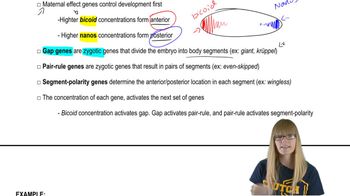Cancer can be defined as an abnormal proliferation of cells that defy the normal regulatory controls observed by normal cells. Recently, histone deacetylation therapies have been attempted in the treatment of certain cancers [reviewed by Delcuve et al. (2009)]. Specifically, the FDA has approved histone deacetylation (HDAC) inhibitors for the treatment of cutaneous T-cell lymphoma. Explain why histone acetylation might be associated with cancer and what the rationale is for the use of HDAC inhibitors in the treatment of certain forms of cancer.
Table of contents
- 1. Introduction to Genetics51m
- 2. Mendel's Laws of Inheritance3h 37m
- 3. Extensions to Mendelian Inheritance2h 41m
- 4. Genetic Mapping and Linkage2h 28m
- 5. Genetics of Bacteria and Viruses1h 21m
- 6. Chromosomal Variation1h 48m
- 7. DNA and Chromosome Structure56m
- 8. DNA Replication1h 10m
- 9. Mitosis and Meiosis1h 34m
- 10. Transcription1h 0m
- 11. Translation58m
- 12. Gene Regulation in Prokaryotes1h 19m
- 13. Gene Regulation in Eukaryotes44m
- 14. Genetic Control of Development44m
- 15. Genomes and Genomics1h 50m
- 16. Transposable Elements47m
- 17. Mutation, Repair, and Recombination1h 6m
- 18. Molecular Genetic Tools19m
- 19. Cancer Genetics29m
- 20. Quantitative Genetics1h 26m
- 21. Population Genetics50m
- 22. Evolutionary Genetics29m
19. Cancer Genetics
Cancer Mutations
Problem 26
Textbook Question
A study by Bose and colleagues (1998). Blood 92:3362-3367] and a previous study by Biernaux and others (1996). Bone Marrow Transplant 17:(Suppl. 3) S45–S47] showed that BCR-ABL fusion gene transcripts can be detected in 25 to 30 percent of healthy adults who do not develop chronic myelogenous leukemia (CML). Explain how these individuals can carry a fusion gene that is transcriptionally active and yet does not develop CML.
 Verified step by step guidance
Verified step by step guidance1
Step 1: Understand the nature of the BCR-ABL fusion gene. This gene results from a chromosomal translocation between chromosomes 9 and 22, creating the Philadelphia chromosome, which produces a constitutively active tyrosine kinase implicated in CML development.
Step 2: Recognize that the presence of the BCR-ABL fusion gene transcript indicates that the gene is transcriptionally active, meaning it is being transcribed into RNA, but this alone does not guarantee disease manifestation.
Step 3: Consider the concept of clonal expansion and additional mutations. For CML to develop, cells carrying the BCR-ABL fusion gene must undergo clonal expansion and acquire further genetic or epigenetic changes that promote uncontrolled proliferation and leukemogenesis.
Step 4: Explore the possibility of immune surveillance and cellular control mechanisms. Healthy individuals may have immune systems or cellular regulatory pathways that suppress or eliminate cells expressing the fusion gene before they can cause disease.
Step 5: Conclude that the detection of BCR-ABL transcripts in healthy adults likely reflects low-level, transient, or non-pathogenic expression of the fusion gene without the necessary secondary events or cellular environment required for CML development.
 Verified video answer for a similar problem:
Verified video answer for a similar problem:This video solution was recommended by our tutors as helpful for the problem above
Video duration:
1mPlay a video:
Was this helpful?
Key Concepts
Here are the essential concepts you must grasp in order to answer the question correctly.
BCR-ABL Fusion Gene and Its Role in CML
The BCR-ABL fusion gene results from a translocation between chromosomes 9 and 22, creating the Philadelphia chromosome. This fusion gene encodes a constitutively active tyrosine kinase that drives uncontrolled cell proliferation, a hallmark of chronic myelogenous leukemia (CML). However, presence of the gene alone does not guarantee disease development.
Recommended video:
Guided course

Segmentation Genes
Clonal Expansion and Additional Genetic Events
For CML to develop, cells carrying the BCR-ABL fusion must undergo clonal expansion and acquire additional mutations or epigenetic changes. These secondary events promote malignant transformation and disease progression, explaining why some individuals with the fusion gene remain healthy without developing leukemia.
Recommended video:
Guided course

Probability
Gene Expression Regulation and Cellular Context
Although the BCR-ABL fusion gene may be transcriptionally active, its expression level, cellular environment, and regulatory mechanisms influence whether it causes disease. In healthy individuals, factors such as immune surveillance and controlled gene expression can prevent the fusion protein from triggering leukemogenesis.
Recommended video:
Guided course

Penetrance and Expressivity
Related Videos
Related Practice
Textbook Question
504
views


